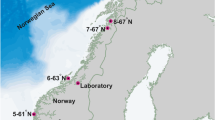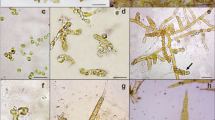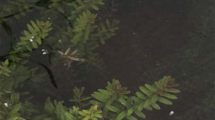Abstract
A study was made of environmental factors affecting the growth of Rhizoclonium riparium in order to evaluate its suitability for large-scale culturing. The results indicate that under the natural conditions prevailing at Taishi, Taiwan, this species can grow year-round, with a monthly biomass production (oven-dried) of 945–1540 kg ha−1 pond surface (assuming a pond depth of 1 m). The specific growth rate ranged from –2.1 to 10.4% per day. Salinity and temperature, both influenced the rate significantly, with optimal values at 20% and 25 °C, respectively. Short (2-mm) lengths of filaments had a higher specific growth rate than longer (20 mm) filaments. Under rotational culturing conditions, the specific growth rate was reduced when flow was increased.
Similar content being viewed by others
References
Biggs BJF, Goring DG, Nikora VI (1998) Subsidy and stress responses of stream periphyton to gradients in water velocity as a function of community growth form. J. Phycol. 34: 598–607.
Bischoff B, Wiencke C (1993) Temperature requirements for growth and survival of macroalgae from Disko Island (Greenland). Helgoländer Meeresunters Res. 47: 167–191.
Caffrey JM (1992) Management of aquatic and invasive riparian vegetation in Irish amenity watercourses. In Mollan C (ed), Water of Life. Royal Dublin Society, Dublin, pp. 130–141.
Caffrey JM, Monahan C (1999) Filamentous algal control using barley straw. Hydrobiologia 415: 315–318.
Chao KP, Su YC, Chen CS (1999) Chemical composition and potential for utilization of the alga Rhizoclonium sp. J. Appl. Phycol. 11: 525–533.
Chao KP, Su YC, Chen CS (2000) Feasibility of utilizing Rhizoclonium in pulping and papermaking. J. appl. Phycol. 12: 53–62.
den Hartog C, Polderman, PJG (1975). Changes in seagrass populations of the Dutch Waddenzee. Aquat. Bot. 1: 141–147.
Eiseltova M, Pokorny J (1994) Filamentous algae in fish ponds of the Trebon Biosphere Reserve – Ecophysiological study. Vegetatio 113: 155–170.
Erler D, Pollard P, Duncan P, Knibb W (2004) Treatment of shrimp farm effluent with omnivorous finfish and artificial substrates. Aquaculture Res. 35: 1–12.
Finlay JC, Power ME, Cabana G (1999) Effects of water velocity on algal carbon isotope ratios: Implications for river food web studies. Limnol. Oceanogr. 44: 1198–1203.
Ghosh M, Gaur JP (1994) Algal periphyton of an unshaded stream in relation to in situ nutrient enrichment and current velocity. Aquat. Bot. 47: 185–189.
Hall DJ, Walmsley RD (1991) Effect of temperature on germination of Rhizocloniun riparium (Siphonocladales, Chlorophyta) akinetes and zoospores. J. Phycol. 27: 537–539.
Hein M, Pedersen MF, Sand-Jensen K (1995) Size-dependent nitrogen uptake in micro- and macroalgae. mar. Ecol. progr. Ser. 118: 247–253.
Imai M, Katayama N, Yamaguchi Y (1997) Effects of salinity on growth, photosynthesis and respiration in a freshwater alga Rhizoclonium riparium (Chlorophyceae, Cladophorales) Phycol. Res. 45: 233–237.
Jones JI, Eation JW, Hardwick K (2000) The effect of changing environmental variables in the surrounding water on the physiology of Elodea nuttallii. Aquat. Bot. 66: 115–129.
Lin MN, Lin KY (1981) The toxicity of radapon (sodium dichlorpionate) and cupric sulfate to Gracilaria, Chaetomorpha and some fishes. China Fish Mon. 343: 3–9.
Mealta EJ, Verschuure JM, Nienhuis PH (2002) Regulation of spatial and seasonal variation of macroalgal biomass in a brackish, eutrophic lake. Helgoländer Meeresunters Res. 56: 211– 220.
McIntire CD, Phinney HK, Larson GL, Buktenica M (1994) Vertical distribution of a deep-water moss and associated epiphytes in Crater Lake, Oregon. Northwest Sci. 68: 11–21.
Mulbry WW, Wilkie AC (2001) Growth of benthic freshwater algae on dairy manures. J. appl. Phycol. 13: 301–306.
Parchevskii VP, Rabinovich MA (1992) Growth rate and harvest of the green alga Enteromorpha intestinalis on artificial substrates in a waste water area. J. mar. Biol. Ass., UK. 17: 30–36.
Peterson CG, Stevenson RJ (1990) Post-spate development of epilithic algal communities in different current environments. Can. J. Bot. 68: 2092–2102.
Phillips A, Lambert G, Granger JE, Steinke TD (1994) Horizontal zonation of epiphytic algae associated with Avicennia marina (Forssk.) Vierh. pneumatophores at Beachwood Mangroves Nature Reserve, Durban, South Africa. Bot. mar. 37: 567–576.
Phillips A, Lambert G, Granger JE, Steinke TD (1996) Vertical zonation of epiphytic algae associated with Avicennia marina (Forssk.) Vierh. pneumatophores at Beachwood Mangroves Nature Reserve, Durban, South Africa. Bot. mar. 39: 167– 175.
Raven JA (1970) Exogenous inorganic carbon sources in plant photosynthesis. Biol. Rev. 45: 167–221.
Ridge I, Walters J, Street M (1999) Algal growth control by terrestrial leaf litter: A realistic tool? Hydrobiologia 395/396: 173–180.
Saravia LA, Momo F, Lissin LDB (1998) Modelling periphyton dynamics in running water. Ecol. Model. 114: 35–47.
Schultz MP (2000) Turbulent boundary layers on surfaces covered with filamentous algae. J. Fluids Eng. 122: 357–363.
Su YC, Wang CH (1998) Current status and reduction strategies for carbon dioxide emission of Taiwan’s pulp and paper industry. Taiwan Tappy J. 1: 8–18.
von Wachenfeldt T (1981) Growth rate of some Baltic macroalgae. Limnologica 15: 311–317.
Wheeler WN (1980) Effect of boundary layer transport on the fixation of carbon by the giant kelp Macrocystis pyrifera. mar. Biol. 56: 103–110.
Author information
Authors and Affiliations
Corresponding author
Rights and permissions
About this article
Cite this article
Chao, KP., Chen, CS., Wang, E.IC. et al. Aquacultural characteristics of Rhizoclonium riparium and an evaluation of its biomass growth potential. J Appl Phycol 17, 67–73 (2005). https://doi.org/10.1007/s10811-005-5554-z
Received:
Revised:
Accepted:
Issue Date:
DOI: https://doi.org/10.1007/s10811-005-5554-z




